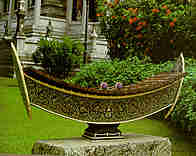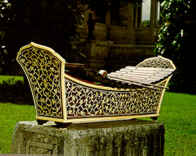|
Ranad Ek The ranad ek is a percussion instrument which evolved from the grap. Originally, a pair of grap was used to keep the rhythm. Later, several grap were made and put in a series, but the tones, when the bars were struck, were coarse and out of tune. Then it was decided to lay them on two tracks or supports. After musicians and instrument makers gained more knowledge and experience, further improvements were made. The grap were constructed in a series of sizes, and a support was devised to hold them in such a way as to allow the tone to sound freely. To accomplish this, a heavy string was threaded though holes made near the end of the grap. The grap were then placed close together on this cord, and the entire “keyboard” was hung on a supporting stand. The keys were struck with two long, slender beaters which had knobs at the ends. One beater was held in each hand. The instrument could now be used to play melodies. Later, improvements were made in the shape of the grap or wooden keys, and a mixture of beeswax with lead shavings was applied to the under side of each key causing the tone to be more “in tune” and thus more beautiful. This instrument was called ranad This type of musical instrument in found in Java, the Mawn or Peguan region of southern Burma and Thailand, and in Burma proper where it is known as the “pattalar" or “bastran.” As for the origin of the instrument, it may have been an original idea of the Thai, or the Thai may have borrowed it from a neighboring country. |
|
Ranad Thum This instrument originated during the reign of King Rama III (1824-1854), being modelled after the ranad ek. The keys are made of similar kinds of wood, but they are longer and wider. The body has a different shape from that of the ranad ek. It is shaped like a long wooden box with the two long top edges slightly curved. The two khon or end pieces extend upward past the top of the curved rims, sometimes curving outward slightly at the top. Between them the keyboard is suspended on its cord which is hung on the metal hooks on the end of pieces. |

